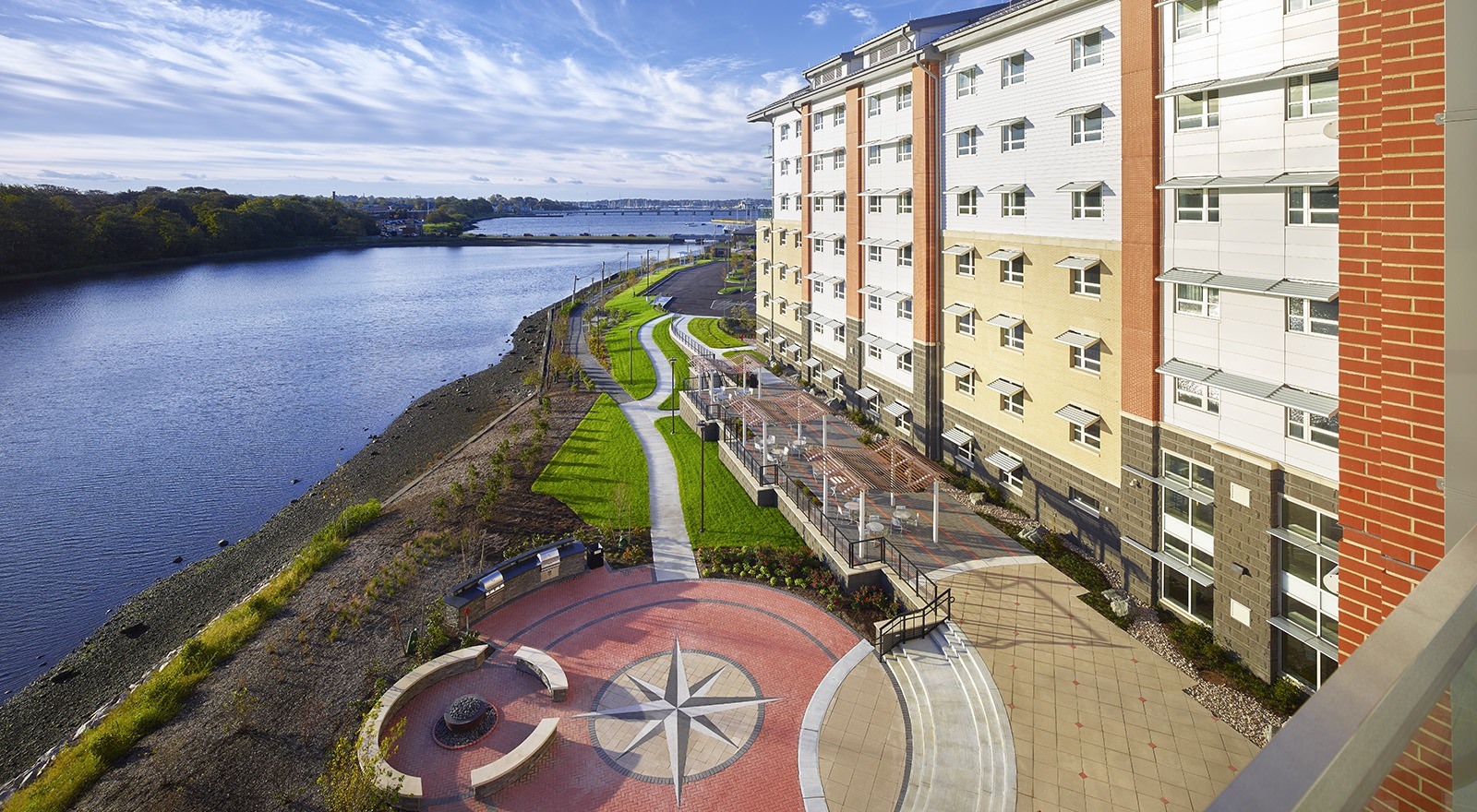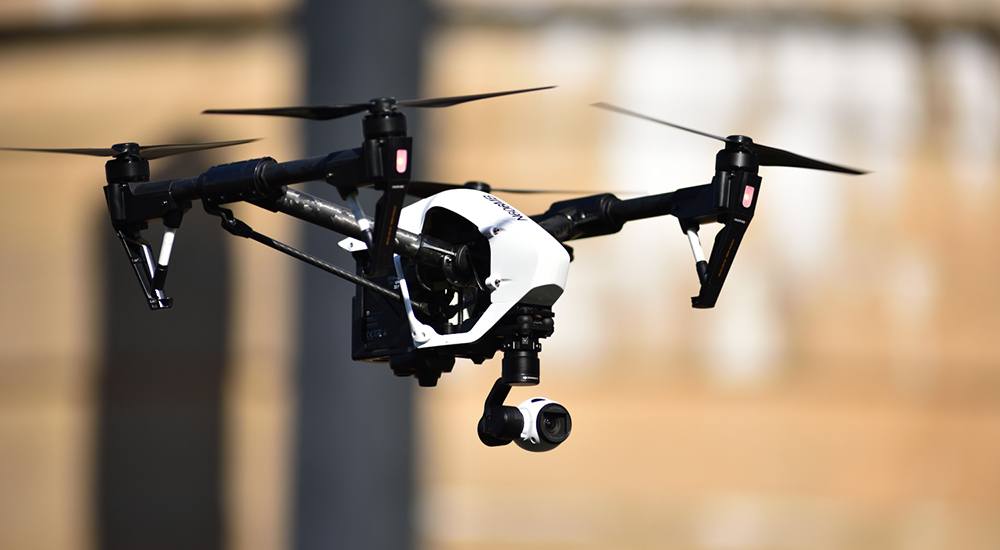Successfully navigating design challenges to set a new standard for U.S. Navy Lodging
From the Summer 2019 issue of Signature
The location, beautifully placed on a scenic stretch of Coasters Harbor, presented a number of challenges and opportunities for Michael Baker International to address as lead designer and primary client conduit for the Navy Gateway Inns & Suites (NGIS) hotel in Newport, Rhode Island.
Along a coastal edge, the effect of tides needed to be addressed. Placed in a frosty corner of New England, extreme temperatures had to be considered. And with the U.S. Navy serving as the client, even greater considerations such as anti-terrorism elements and personnel protection had to be priorities.
In the end, each of those challenges — and more — were surmounted, resulting in the new hotel, which now stands as the standard for all NGIS facilities worldwide.
Michael Baker relied heavily on the design-build process for the Newport NGIS, according to Project Manager and Vice President of Architecture Joseph Chaffin, AIA.
“We had a team that worked well and was experienced and talented to approach a project like this,” Chaffin explained. “This Navy opportunity was unique. With most projects, the client provides a document illustrating design intent, but this was different. The Navy said it would benefit from outside perspectives, since Newport represented a worldwide lodging program prototype that needed to be comparable to the commercial hospitality market.”
WHY THE NAVY CHOSE DESIGN-BUILD
“Design-build is very important from a collaborative architectural perspective,” Chaffin said. “Michael Baker has been executing design-build work for decades with federal government projects. In the case of Newport, the client realized they could be more efficient in procurement, design and construction by managing those functions simultaneously. We have developed relationships with national contractors, leading to a more integrated approach. It is important to not design in a vacuum, and design-build represents a more fluid process because we are evaluating solutions and making decisions collectively.”
The 103,831-square-foot Newport NGIS includes 194 guest rooms, six guest suites, front-of-house public areas, back-of-house support areas and corresponding site development, utility infrastructure, landscaping, parking, exterior terrace and amenities. The project achieved LEED® Silver certification and is a first of its kind for the Navy. It improves the quality of the guest experience, incorporating the latest and best trends and innovations the hospitality industry has to offer.
Situated on a very prominent location with respect to the surrounding greater Newport area, the NGIS benefited from Michael Baker’s coordinated site and architectural design to maximize the building’s appeal to the surrounding community and visitors. For guests, the design features views of the harbor and marina and creates exterior space opportunities. The project establishes a “signature” image for future NGIS facilities, with an angled, seven-story L-shape configuration integrated into the site and oriented toward Coasters Harbor, featuring landscaped, terraced exterior patios extending the two-story lobby lounge toward water views.
“Naval Station (NS) Newport is unlike any other Navy Gateway Inns & Suites and has become a benchmark of what can be done for our mobile military forces,” said Norman Aurland, CLM, CHFE, Regional Lodging Program Director, Navy Region Mid-Atlantic, and primary client contact on the NGIS project.
“When designing and building NS Newport, our goal was to design it like a hotel; however, we also were required to comply with all of the Navy’s guidelines for construction,” said Aurland. “This in itself added features that may not be found in a civilian hotel simply because it is on a Navy installation. Future projects will without a doubt use the design features developed in this project.”
GREEN BY DESIGN
LEED strategies and energy-reduction concepts were incorporated into the design to comply with UFC 1-200-02 High Performance and Sustainable Building Requirements. The project easily exceeds Energy Policy Act (EPAct 2005) standards by 46.6 percent (30 percent required) and achieved 23.7 percent savings per LEED. Energy modeling software helped determine the optimal design solution for this building configuration.
Additional sustainable strategies include a 35 percent reduction in water usage and reduced hot water demand, low volatile organic compounds (VOC) materials, reflective “cool” roofing and native plantings. In addition, all spaces throughout the facility were designed to maximize the admission of natural light and views, a key sustainability concept incorporated into the design for LEED® Silver certification.
“With design-build and architecture in general, every project is custom,” Chaffin noted. “As the project moves forward, we are always encountering new challenges in sustainability, energy, climate zone and the exterior envelope of the building, among other things.”
COLLABORATING FOR SOLUTIONS
“At Newport, potential storm surge and wave action became a serious consideration,” Chaffin said. “We needed to understand how the foundation could withstand coastal erosion. Prescriptive environmental considerations regarding the coastal edge of the site became critical. To help our team understand the wave action and tidal surges at the Newport site, we consulted with our associates in Michael Baker’s Virginia Beach office. With that understanding in hand, we could then better work with our contracting partners to get the most innovative system developed and built.”
Other steps taken on the Newport site during the design-build process included relocating plantings to protect native species, working around potential environmental contaminants by shifting the placement of the building itself and successfully contending with a rough winter along the coast of Rhode Island.
Winter conditions, with extreme low temperatures and snow, meant working with the contractor during construction to augment systems to help stay on schedule, protect the integrity of the project and — most of all — to keep everyone safe. In one instance, the protective weather barrier continuous around the periphery of the structure had to be changed to a different thickness and strength to withstand the harsh winter conditions so work could continue inside.
“Projects take on lives of their own,” Chaffin said. “The Newport NGIS took five years from bid to completion. Our experience here helps the design-build process continue to evolve and today allows us to demonstrate an expanded design perspective. We are interdisciplinary with architecture, interior design, comprehensive building engineering of all disciplines, all working together. We have an entire network of expertise across our Company, which proved to be extremely valuable with the Newport project.”
DELIVERING EXCELLENCE
“Especially with federal projects like this one, evaluations are critical,” Chaffin explained. “If you have a poor performance score on one project, representatives from any other branch of the service can see that.”
On the official Navy Past Performance Questionnaire for the Newport NGIS project, Michael Baker received “Excellent” marks in 16 of 19 pertinent subjects, with the remaining three earning “Very Good” scores, proving once again how – despite the challenges of tides, temperatures and tight security – design-build enables solutions to complex problems and can even set a new standard of excellence.




